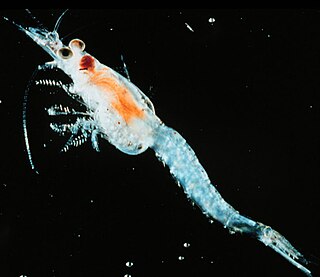
Amphipoda is an order of malacostracan crustaceans with no carapace and generally with laterally compressed bodies. Amphipods range in size from 1 to 340 millimetres and are mostly detritivores or scavengers. There are more than 9,900 amphipod species so far described. They are mostly marine animals, but are found in almost all aquatic environments. Some 1,900 species live in fresh water, and the order also includes the terrestrial sandhoppers such as Talitrus saltator and Arcitalitrus sylvaticus.

Mysida is an order of small, shrimp-like crustaceans in the malacostracan superorder Peracarida. Their common name opossum shrimps stems from the presence of a brood pouch or "marsupium" in females. The fact that the larvae are reared in this pouch and are not free-swimming characterises the order. The mysid's head bears a pair of stalked eyes and two pairs of antennae. The thorax consists of eight segments each bearing branching limbs, the whole concealed beneath a protective carapace and the abdomen has six segments and usually further small limbs.

Mysidae is the largest family of crustaceans in the order Mysida, with over 1000 species in around 170 genera.

Cumacea is an order of small marine crustaceans of the superorder Peracarida, occasionally called hooded shrimp or comma shrimp. Their unique appearance and uniform body plan makes them easy to distinguish from other crustaceans. They live in soft-bottoms such as mud and sand, mostly in the marine environment. There are more than 1,500 species of cumaceans formally described. The species diversity of Cumacea increases with depth.

The bloody-red mysid, Hemimysis anomala, is a shrimp-like crustacean in the Mysida order, native to the Ponto-Caspian region, which has been spreading across Europe since the 1950s. In 2006, it was discovered to have invaded the North American Great Lakes.

Mysis is a genus of mysid crustaceans in the family Mysidae, distributed mainly in the coastal zone of the Arctic and high boreal seas. Several species also inhabit northern freshwater lakes and the brackish Caspian Sea. Fifteen species are recognized. Body lengths range from 1 to 3 centimetres.

Nannastacidae is a family of crustaceans belonging to the order Cumacea. They have no free telson. The endopods of the uropods are present on one segment. There are exopods on the maxillipeds and generally one on pereopods 1–4 in males and 1–2 in females. In the females the second antenna is much shorter than the first. It contains the following genera:

Paramysis baeri is a species of mysid crustacean from the genus Paramysis, named in honour of the prominent biologist Karl Ernst von Baer. Its body is 13–31 millimetres (0.51–1.22 in) long, and it is only found in the coastal waters of the Caspian Sea, on sandy and muddy bottoms, at depths of less than 20 m (66 ft). For over a century, it was thought to be distributed throughout the whole Ponto-Caspian basin, but recently the range was reconsidered after the rediscovery and re-establishment of the closely related species Paramysis bakuensis. Since the taxonomical status of P. baeri has been reconsidered, the distribution and ecology of the species remains poorly known. Paramysis baeri can be distinguished from P. bakuensis and other species of the subgenus Paramysis s. str. by the rather broad, almost quadrangular exopod of maxilla 2, the strongly serrated paradactylar claw-setae of pereiopod 6, and other features.
Paramysis bakuensis is a species of mysid crustacean from the family Mysidae, named by the locality from where it was originally described, the town of Baku in Azerbaijan by the Caspian Sea.

The clade Multicrustacea constitutes the largest superclass of crustaceans, containing approximately four-fifths of all described crustacean species, including crabs, lobsters, crayfish, shrimp, krill, prawns, woodlice, barnacles, copepods, amphipods, mantis shrimp and others. The largest branch of multicrustacea is the class Malacostraca.
Erythrops elegans is a species of crustaceans in the family Mysidae. It is found in the northeastern Atlantic Ocean and in the Mediterranean Sea.

Heteromysis is a genus of marine mysid crustaceans from the family Mysidae, associated with various shallow-water invertebrates. The name describes differentiation of its pereiopods as possible adaptation to commensal life-style. Heteromysis is one of the largest mysid genera, containing more than 100 species. The genus is distributed globally, but predominantly in tropical and subtropical waters.
Paramysis intermedia is a species of shrimp in the family Mysidae. Its natural distribution is Ponto-Caspian, but it is also invasive species, e.g. on the Baltic coast of Estonia. It tolerates salinities between 0–12 ppt; it occurs in estuaries but does not penetrate very deep into rivers.
Iphigenellidae is a freshwater family of amphipods in the superfamily Gammaroidea. It is found in the Ponto-Caspian region, which encompasses the Black, Azov, and Caspian Seas.
Neobirsteiniamysis inermis is a deepwater mysid crustacean species of the genus Neobirsteiniamysis. One of the largest and the only known mysid, distributed in both polar regions.
Boreomysinae is a subfamily of large, mostly deep-water oceanic mysid crustaceans from the family Mysidae. The name, which can be translated as "northern mysids", comes from the genus Boreomysis G.O. Sars, 1869, established for Boreomysis arctica from the boreal waters of Atlantic. As more species have been discovered subsequently, the subfamily is considered panoceanic, and includes 38 species from two genera, Boreomysis and Neobirsteiniamysis Hendrickx et Tchindonova, 2020.
Boreomysis is a mysid crustacean genus, the type of the subfamily Boreomysinae of the family Mysidae. Majority of the species are found in the ocean deep water. Cosmopolitan. 38 species.
Boreomysis sibogae is a species of mysid crustaceans from the subfamily Boreomysinae. It is also a member of the nominotypical subgenus Boreomysis sensu stricto. The species is an epi-bathypelagic mysid, widely distributed in the Indo-Pacific and possibly also in the Atlantic Ocean.
Boreomysis sphaerops is a species of mysid crustaceans from the subfamily Boreomysinae. It is also a member of the nominotypical subgenus Boreomysis sensu stricto. The species is a meso-bathypelagic mysid, distributed in the West Indo-Pacific, although known only from few records off Japan and Australia.









